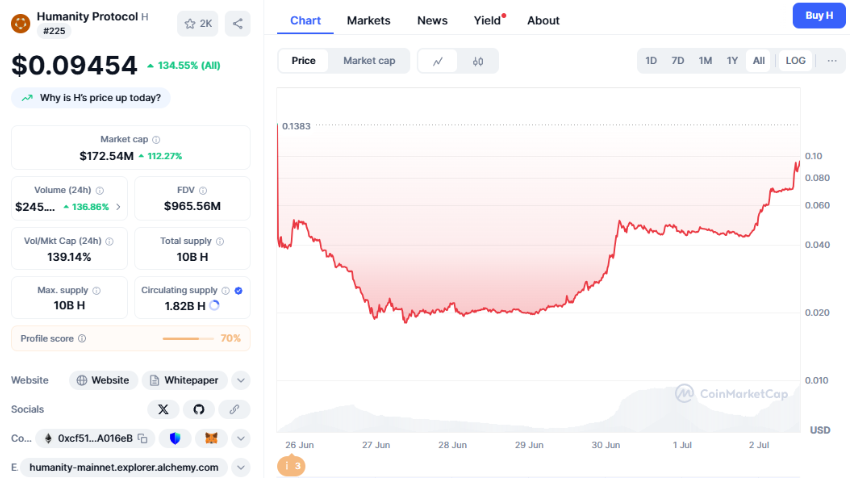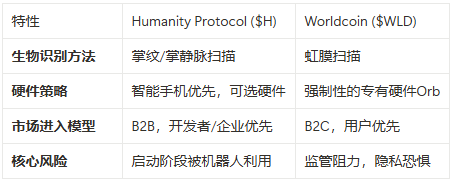The early airdrop activity exposed trust flaws due to bot attacks, leading to severe market fluctuations.
Written by: Oliver, Mars Finance
When the K-line chart of $H once again drew that spine-chilling green giant bar, surging 95.2% within 24 hours, the entire cryptocurrency market seemed to hear two intertwined voices: one was the ecstatic shouts of those who had boarded the wealth express, and the other was the alarm bells ringing over the enormous controversy surrounding this project. Dubbed a "demon coin" by the market, the Humanity Protocol has a story far more complex than a simple myth of sudden wealth. It once soared to the forefront of major exchanges like Bitget, achieving a 125% single-day increase; it also plummeted over 61% due to a catastrophic trust crisis right from its inception.

This extreme volatility, akin to ice and fire, is not merely a result of market speculation. It represents a real-time change in the odds of a grand gamble, with the stakes being: in an era where artificial intelligence (AI) increasingly blurs the boundaries between humans and machines, how do we prove "I am a human"?
The story of H is an epic about a "flawed savior" attempting to answer this ultimate question. It has two completely opposite yet simultaneously existing narrative threads: one is the "bright line" led by top venture capital firms Pantera Capital and Jump Crypto, valued at $1.1 billion; the other is the "dark line," where the founder openly admitted that the network was "occupied" by bots, and the airdrop turned into a disaster. It is the tug-of-war between these two forces that has created H's "demonic" nature.
Vision: Forging a "Human Layer" in the Mist of AI
The story of $H begins in an era of increasingly urgent anxiety. As nearly half of internet traffic comes from bots, and deepfake technology is capable of creating convincing forgeries, the foundation of trust in the digital world is crumbling. "Witch attacks"—where a single entity manipulates the network by creating numerous fake identities—are eroding every corner of the Web3 world like a plague.
The birth of the Humanity Protocol is precisely to address this crisis. Its vision is grand and exhilarating: to build a global foundational "trust layer" or "human layer," aiming to "bring the first billion humans into Web3."
To achieve this seemingly impossible task, it has designed a sophisticated technical solution:
A gentler "Proof of Humanity": At its core is the "Proof of Humanity" (PoH). However, unlike its competitor Worldcoin, which controversially uses iris scanners (Orb), $H opted for a less invasive and more publicly acceptable palm print recognition. In the first phase, users only need to verify through their smartphone cameras, significantly lowering the participation threshold.
Privacy-first zero-knowledge proofs: To alleviate fears of biometric data leakage, the protocol employs zero-knowledge proofs (ZKPs) technology. Users' palm print information is converted into a string of encrypted mathematical gibberish on local devices, completing the verification of "humanity" without disclosing any original data.
A solid underlying architecture: It has built a Layer 2 network compatible with Ethereum based on Polygon CDK, ensuring its future scalability and developer-friendliness.
This perfect "dragon-slaying story" attracted top-tier capital to enter the fray, laying the groundwork for its subsequent surge.
Original Sin: A Protocol Against "Witches" Being Overrun by "Witches"
However, just as this dragon-slaying warrior was about to reveal his sword in a moment of glory, he was bitten hard by the very dragon he vowed to eliminate. This constitutes the indelible "original sin" in the story of $H.
During its token airdrop event named "Fairdrop," disaster struck. A protocol whose core mission was to resist witch attacks ironically fell victim to a massive army of bots during its initial token distribution.
The crisis was ignited by founder Terrance Kwok's candid admission during a community dialogue. He acknowledged that among the 9 million "human IDs" heavily promoted by the project, "a considerable portion is actually bots," while the number of genuine human users "is approaching one million."
This means that as much as 88% of the early user data could be false. For a "Proof of Humanity" project, this is a fatal blow to trust. Once the news broke, community trust collapsed instantly, and the token price plummeted. What should have been the fairest airdrop turned into a carnival for "scientists" (referring to professionals profiting from scripts) and a disaster for real users.
This failure profoundly revealed the project's fatal misstep: it hastily opened the treasury doors to a group of weakly protected early accounts before its most powerful weapon—palm print scanning verification—was widely deployed and enforced. This is akin to distributing treasure before the castle is even built.
The Mirror Battle with Worldcoin and Philosophical Reflections with Vitalik
$H is not fighting alone; from its inception, it has been embroiled in a sovereignty battle concerning the future of "digital identity." To understand its positioning, it must be viewed in the context of its main competitor Worldcoin and the profound reflections of Ethereum founder Vitalik Buterin.

The strategic intent of $H is crystal clear: it exists almost as a "mirror" of Worldcoin, attempting to systematically address every pain point exposed by the latter. Worldcoin's Orb hardware is centralized and unsettling, while $H focuses on lightweight mobile scanning; Worldcoin's iris data collection has triggered a global regulatory storm, and $H opts for the "less invasive" palm print. It acts like a keen "fast follower," leveraging the trial and error of the pioneer to provide the market with a seemingly better option.
However, despite their tactical opposition, from a broader philosophical perspective, both may fall into the "single trap" warned by Vitalik Buterin. V has repeatedly cautioned that any single identity verification system, no matter how ingeniously designed, once it dominates, could erode the precious "pseudonymity" of the internet and ultimately become a tool for surveillance. He advocates for a diversified identity system. From this angle, the war between $H and Worldcoin may not matter in terms of who wins or loses; what is truly concerning is whether this war will end with one side's "complete victory."
VCs, Genomics, and Cross-Industry Ambitions
The confidence of $H comes not only from its technical narrative but also from the powerful capital and strategic alliances behind it. The "war fund" of over $50 million from top VCs like Pantera Capital and Jump Crypto is the foundation of its audacious gamble. The VCs' bet is that in the AI era, reliably verifying "humanity" will become a trillion-dollar essential market.
If the VC funding is the ammunition, then its series of strategic collaborations form its combat troops, with ambitions far beyond merely "proving you are human."
The most eye-catching and controversial is its partnership with Nasdaq-listed genomics company Prenetics. According to the agreement, Prenetics will utilize its flagship product CircleDNA to issue "Proof of Humanity" certificates through DNA testing.
This pushes biometric identity verification to its logical extreme—DNA is currently the most unique and hardest-to-forge personal identifier known. If successful, this move will create an unparalleled competitive barrier for $H. However, it also places the project in a more complex and sensitive ethical and regulatory minefield than iris scanning. Combining genetic data—even just its encrypted hash value—with immutable blockchain technology crosses a river of bioethical Rubicon.
A Necessary Gamble or a Faustian Bargain?
Looking at the entire story of $H, we see a complex entity filled with contradictions. It attempts to solve a real and severe problem, has a grand technological vision, and boasts a strong capital background. However, its start is staggered due to its own negligence, and its core technical solution places it in the eye of ethical and legal storms.
The story of $H is a microcosm of the entire Web3 experiment. It showcases the immense potential of decentralized technology to reshape social infrastructure while exposing the governance chaos, incentive misalignment, and severe friction with real-world rules it faces on its path to maturity.
So, what story does the "demon coin" $H tell with its renewed surge?
It tells the story of a "flawed savior" struggling to survive in the AI era. It proclaims the value of its vision to the world through its surge while paying the price for its "original sin" through its plunge. Each price fluctuation is a re-vote by the market on this grand experiment.
Supporting or participating in $H is not just an investment; it is a statement about a future paradigm of identity. The ultimate outcome of this gamble is unknown: will we usher in a fairer, more authentic internet, or will we inadvertently make a deal with the devil in the pursuit of technological solutions, trading ultimate privacy for proof of "humanity"?
The answer remains in the wind, and $H, regardless of success or failure, will be an undeniable character in this grand drama of the era.
免责声明:本文章仅代表作者个人观点,不代表本平台的立场和观点。本文章仅供信息分享,不构成对任何人的任何投资建议。用户与作者之间的任何争议,与本平台无关。如网页中刊载的文章或图片涉及侵权,请提供相关的权利证明和身份证明发送邮件到support@aicoin.com,本平台相关工作人员将会进行核查。




